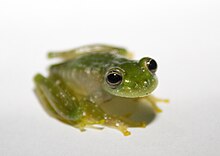Cochranella pulverata
| Powdered glass frog | |
|---|---|
 |
|
| Scientific classification | |
| Kingdom: | Animalia |
| Phylum: | Chordata |
| Class: | Amphibia |
| Order: | Anura |
| Family: | Centrolenidae |
| Genus: | Teratohyla |
| Species: | T. pulverata |
| Binomial name | |
|
Teratohyla pulverata (Peters, 1873) |
|
| Synonyms | |
|
Many, see text |
|
Many, see text
The powdered glass frog or Chiriqui glass frog, Teratohyla pulverata, is a frog species in the glass frog family (Centrolenidae). It is found from north-central Honduras south to northwestern Ecuador.
Teratohyla pulverata is a small glass frog, lacking humeral spines in males, and has a lobed bulbous liver, placing it in the genus Cochranella. Adult males measure 22-24.5 mm from the snout to the vent, while the females are larger at 25.3-28.3 mm snout-vent length. The snout is rounded if seen from above, but presents a distinctly sloped profile when viewed from the side. The translucent tympanum is visible but not large, measuring about one-fifth to one-fourth of the eye's diameter; the tympanic annulus is not hidden except for the dorsal margin, which is covered by the supratympanic fold.
Their color is green above, with a rich scattering of small, white spots – hence the species' scientific name, which means "the powdered one". The back has a rough shagreen-like texture, particularly in males, where it is covered in tiny . The belly is transparent and has a grained texture. Thus, the green bones and some internal organs can be observed in the living animal – particularly as this species' parietal (outer) peritoneum is completely translucent, too; the inner peritonea covering the liver and gastrointestinal tract are white. The iris is greyish-white with tiny yellow dots and a network of thin, dark-grey lines; a thin cream-yellow ring surrounds the pupil. Melanophores are abundant on the dorsal surface of the fourth finger, but absent on the first three fingers. Preserved specimens are usually cream-colored to light lavender above, with the spotting remaining white or becoming transparent.
...
Wikipedia

